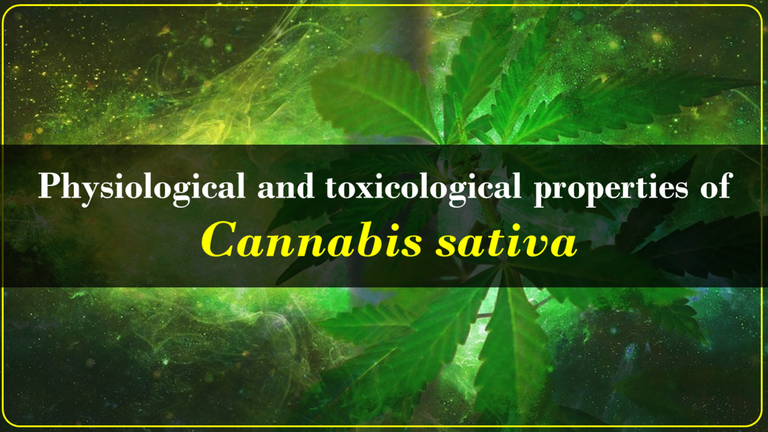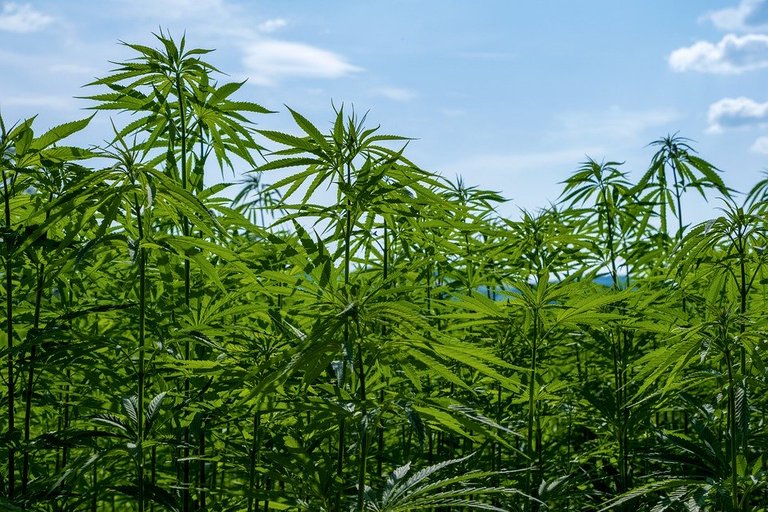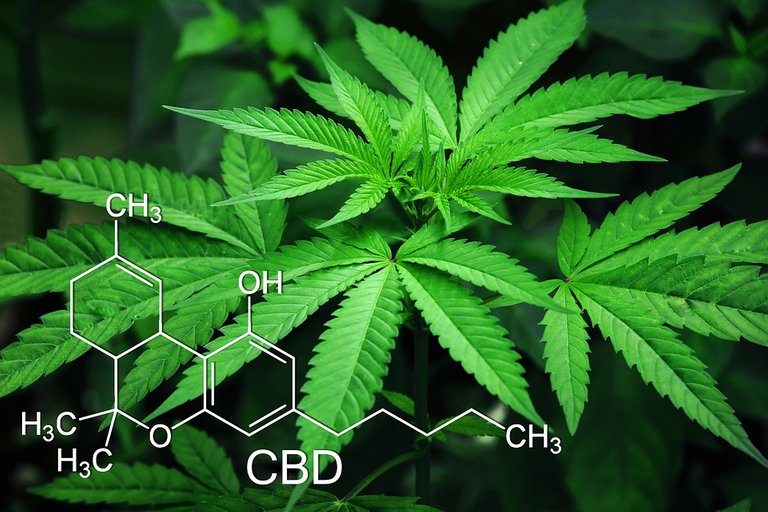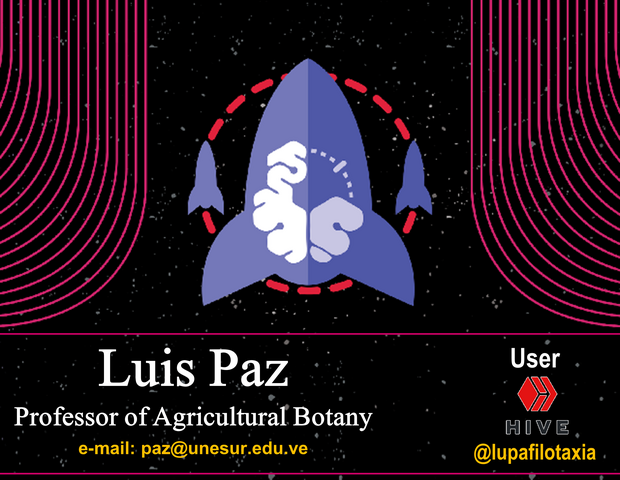Physiological and toxicological properties of Cannabis sativa

This delivery, I will socialize information on the general characteristics, pharmacokinetic action, pharmacological effects, psychoactive effects, consumption and legal aspects of one of the main psychoactive species, in this opportunity on Cannabis sativa.
Introduction
Psychoactive flora is a group of plant species that synthesize substances analogous to neurotransmitters from the biological point of view and whose biochemical effect activates the transfer of nervous impulses in humans, generating alterations in the perception of space and time.
In addition to alterations in the perception of space and time, psychoactive plant species also act by transforming the normal conscious state into prolonged periods of euphoria, paranoia, agitation, anxiety and sleep, essentially through their hallucinogenic and narcotic effects.
However, considering the generalized perception that exists on the consumption of psychoactive plant species, in addition to the scarce technical-didactic information on their physiological and toxicological properties, the objective of the present post is to socialize botanical aspects related to the pharmacokinetic action, pharmacological and psychoactive effects of the Cannabis sativa species.
General features
Taxonomy and distribution
Cannabis sativa, is a plant species of herbaceous biotype, artificially located in the Division: Magnoliophyta., Class: Magnoliopsida., Order: Urticals., Family: Cannabaceae., Genus: Cannabis and Species: sativa, of Asian origin and extensive range in both temperate, tropical and subtropical eco-regions.
Common names
According to [1], Cannabis sativa is invariably identified as Marijuana, however, it is also often referred to as Hemp, Kalamu, Herb, or Bangue from India.
Vegetative and reproductive morphology
The specimens of Cannabis sativa, present herbaceous and erect stem, composed and palm-like foliar laminae (leaflets in variable number at the end of the rachis), lanceolate and accumulated aspect, with glandular trichomes in the segment of the beam and stipules in the zone of insertion of the petiole, serrated margin, alternate phyllotaxy, monochlamydial or appetal flowers (without petals), cimosa inflorescences and fruits type aquarius of ovoid morphology [2] .

Fig. 2 Cannabis sativa seedlings. Image of public domain, Author: James S, 2015 / CC BY-SA 2.0
Edaphoclimatology of Marijuana
Marijuana as a crop, physiologically expresses its maximum vegetative and reproductive potential in subtropical conditions, which present light intensity between 400 - 700 nm, average rainfall of 1,800 millimeters per year, temperatures between 20 and 25 ° C, humidity of 60 to 70%, exhibiting soil fertility high in calcium, potassium and humic substances, and slightly acidic pH 5.5 and 6.5.

Fig. 3 Cultivated specimens of Cannabis sativa. Image of public domain
Pharmacokinetic action
Conceptualization
Pharmacokinetics is the area of pharmacology that relates the biological movements of natural substances, or drugs in the human body, in the search for knowledge of their bio-absorption, distribution, extraction, bio-transformation, receptors where they act, in addition to the physiological and toxicological effects before their excretion from the body [3].
Pharmacokinetics of cannabinoid substances
In relation to the pharmacokinetic action of cannabinoid substances, the main compounds synthesized biologically by the psychoactive species Cannabis sativa, authors such as [4], indicate that the numerous processes developed in the human body by these psychoactive substances of Marijuana are; uptake by specific receptor proteins such as CB1 (central nervous system) and CB2 (gastrointestinal tract, peripheral nervous system, spleen and immune system cells), which is why, physiologically, they act on neuro-immune and endocrine activity, mediating neuromodulatory, antipsychotic and antiepileptic responses, and then they are distributed and metabolized by the liver, released or expelled through feces and urine.

Fig. 4 Chemical structure of Tetrahydrocannabinol, the main component of Cannabis sativa. Image of public domain
Pharmacological effects
Clinical Answers
According to numerous clinical trials in children, the main pharmacological effects of psychoactive substances present in the vegetative and reproductive structures of marijuana (Cannabis sativa) are as follows: anti-inflammatory, antiemetic, muscle relaxant and analgesic, hence its use is recommended in multiple medical treatments to counteract severe pain, nausea, vomiting, epilepsy, sclerosis [5] .
Addictive effects of Cannabis sativa
Reported Toxicological Disorders
Within the innumerable addictive responses, that exert the psychoactive substances cannabinoids, products of the effects of sedation, relaxation, sensation of euphoria, creativity, constant hallucination, overestimation of the time, increase of the appetite, positive answers in psychiatric syndromes, such as depression, disorders of the dream, and before the absence of medical dosage by legal reasons, the consumption of Cannabis sativa generates addictive effects that create multiple toxicological upheavals and consequences on the health, like for example; psychosis, schizophrenia, mental problems, respiratory and cardiovascular diseases, however, it is necessary to indicate that the anxiety generated by the consumption of C sativa, ends up altering the behavior of the people when becoming totally dependent on the Marijuana, aspects that cause adverse social effects, as much at familiar level as work.

Fig. 5 Crushed Cannabis sativa vegetative and reproductive segments for preparation of rolls or joints. Image of public domain, Author: Motiur R, 2016 / CC BY-SA 4.0
Cannabis sativa consumption and legal aspects
Legal provisions
Even though, on a global scale, amended legal provisions of the Single Convention on Narcotic Drugs of 1961 have been imposed, prohibiting the consumption of substances derived from Cannabis sativa, due to its stimulant and hallucinogenic effects, which have positioned Marijuana as an illegal drug, there are few controls or audits implemented in most countries of the world, to stop the health and social problems it generates in people who consume psychoactive substances of Cannabis sativa [6].
Use of Cannabis sativa psychoactive substances
The harmful effects of marijuana have probably not been an issue of government interest at the international level, hence, it is consumed illegally and exaggerated by the following forms; inhalation either smoked or vaporized, orally by infusion or maceration with alcohol, and sublingually for rapid absorption.
SCIENTIFIC CONTRIBUTIONS OF THIS PUBLICATION
- In summary, the thematic content presented on; physiological and toxicological properties of Cannabis sativa, provides synthesized information related to the general characteristics, pharmacokinetic behavior, pharmacological and psychoactive effects presented by Marijuana, in addition to focusing on the widespread failure to comply with the 1961 Single Convention on Narcotic Drugs, which prohibits the use of substances derived from C. sativa.
BIBLIOGRAPHICAL REFERENCES CONSULTED AND CITED:
[1] Rodríguez E., y Zamora R. Cannabis ¿una opción terapéutica? Cannabis: a therapeutical option?. 16 de Abril. 2019; 58; 272: 29-30. Article: Online access
[2] López A., Guadalupe E., Brindis F., Niizawa C., Ventura R. Cannabis sativa L., una planta singular. Rev Mex Cienc Farm. 2014;45:4. Article: Online access
[3] Armijo J. Farmacocinética: Absorción, Distribución y Eliminación de los Fármacos. En: Flórez J, Armijo JA, Mediavilla A, Farmacología Humana. Masson. Barcelona. 2003;4:51-79. Article: Online access
[4] Devilat M., Manterola C., Moya J. Tratamiento compasivo y de acompañamiento con Cannabis en niños con epilepsia resistente: una presentación de 2 pacientes y revisión de la literatura. Rev Chil Epilepsia. 2014;14;3:6-17. Article: Online access
[5] Wong S., Wilens T. Medical cannabinoids in children and adolescents: a systematic review. Pediatrics 2017;140;5:1-16. Article: Online access
[6] CGPD. Informe de la Comisión Global de Políticas de Drogas. La clasificación de sustancias psicoactivas cuando se dejó atrás a la ciencia. 2019. Article: Online access
ATTENTION
Readers and followers
If you wish to read more scientific articles in English or Spanish, of excellent academic quality, do not hesitate to visit #STEMSocial and #STEM-espanol, communities that promote scientific content mainly in the areas of Science, Technology, Engineering and Mathematics.
OBSERVATION

0
0
0.000
This post has been manually curated by @steemflow from Indiaunited community. Join us on our Discord Server.
Do you know that you can earn a passive income by delegating to @indiaunited. We share 80 % of the curation rewards with the delegators.
Here are some handy links for delegations: 100HP, 250HP, 500HP, 1000HP.
Read our latest announcement post to get more information.
Please contribute to the community by upvoting this comment and posts made by @indiaunited.
Thank you for supporting this kind of content with your vote. Best regards, I'll check your channel.
You are welcome. 🙂
#posh Twiteer:
https://twitter.com/lupafilotaxia/status/1275330115149447169
Cannabis is quite popular all over the world and yet, there are some other plants with psychoactive contents that are more sophisticated than cannabinoid.
This is a lovely information about cannabis. You should consider cross-posting to the cannabis community.
Greetings @gentleshaid new thanks for visiting the blog. Precisely the idea of this delivery is to upload content related to the psychoactive principles of the most recognized species, besides Cannabis, species like Cocaine, Poppy, Tobacco and Coffee.
Thanks for your contribution to the STEMsocial community. Feel free to join us on discord to get to know the rest of us!
Please consider supporting our funding proposal, approving our witness (@stem.witness) or delegating to the @stemsocial account (for some ROI).
Thanks for using the STEMsocial app and including @stemsocial as a beneficiary, which give you stronger support.
Hi,
An informative and thought-provoking article.
I think the greatest issue with Cannabis is the lack of research. That the drug can be therapeutic is certain, and that its use may be problematic for some people (disruptive to life), is also certain. However, very little is known about how to use the drug therapeutically (ex: effective dose), and which populations may be more susceptible to abuse. Research has been limited because the government (at least in the US) has limited researchers' access to the substance.
A couple of things are true: in many cases the pharmaceuticals replaced by cannabis generally have higher adverse events associated (ex: benzodiazapam and muscle relaxants). Also, addictive aspect of cannabis is lower than legal recreational drugs (alcohol) and legally prescribed drugs (opiods).
I think as soon as we can do peer reviewed. controlled studies on cannabis we will be able to more clearly decide the benefits and risks of this drug.
Yes, the article is definitely thought-provoking :)
Greetings @agmoore, thanks for visiting the blog.
There are many reasons why cannabis is not used therapeutically, however, I believe that the main reason is that the pharmaceutical industry has no interest in promoting the use of phytopharmaceuticals, as the lucrative business for the pharmaceutical sector has been and will be synthesizing molecules. Therefore, historically they have maintained under the shadow all the therapeutic and medicinal potential that the secondary metabolites of certain plant species have on health, which is why in coordination with governments and institutions they do not promote research that tends to give favorable results for the extraction, elaboration and dosage of phytopharmaceuticals.
Hello, and thank you for that response.
I agree with you 100%